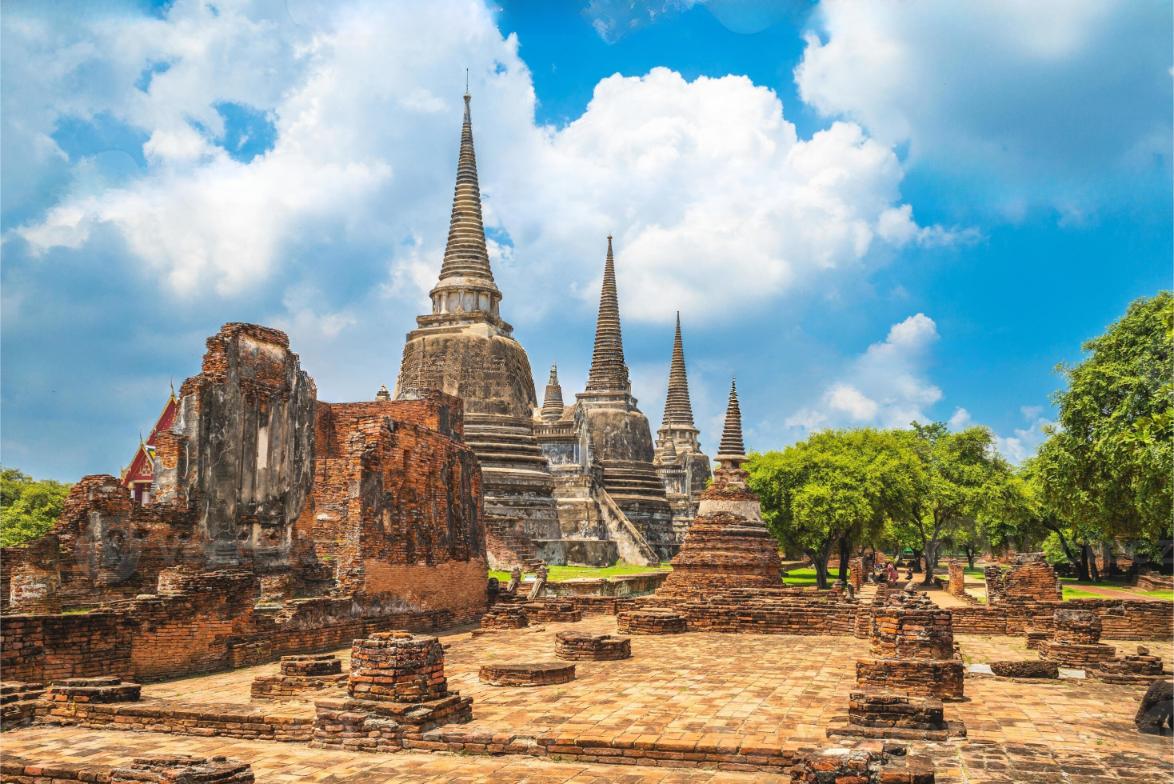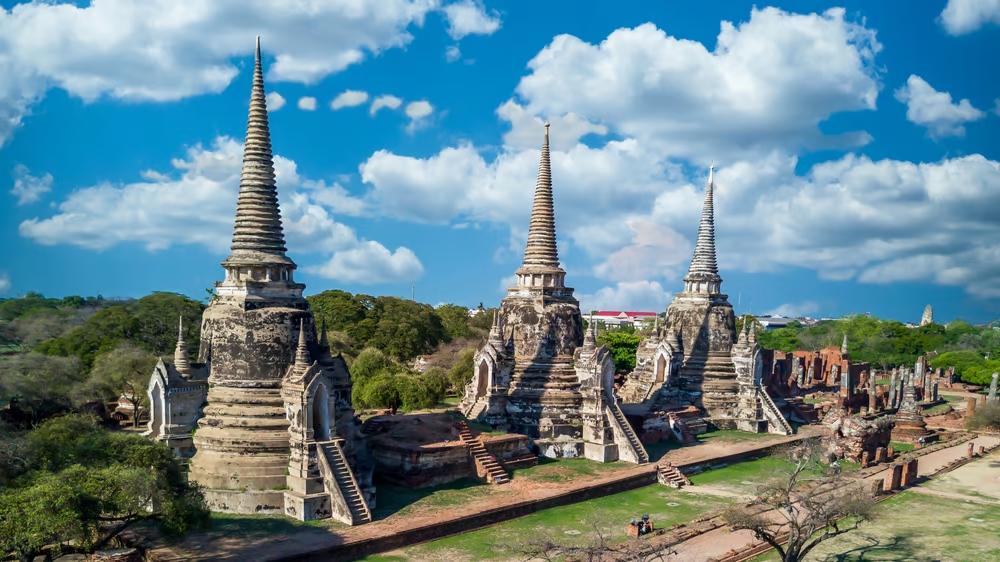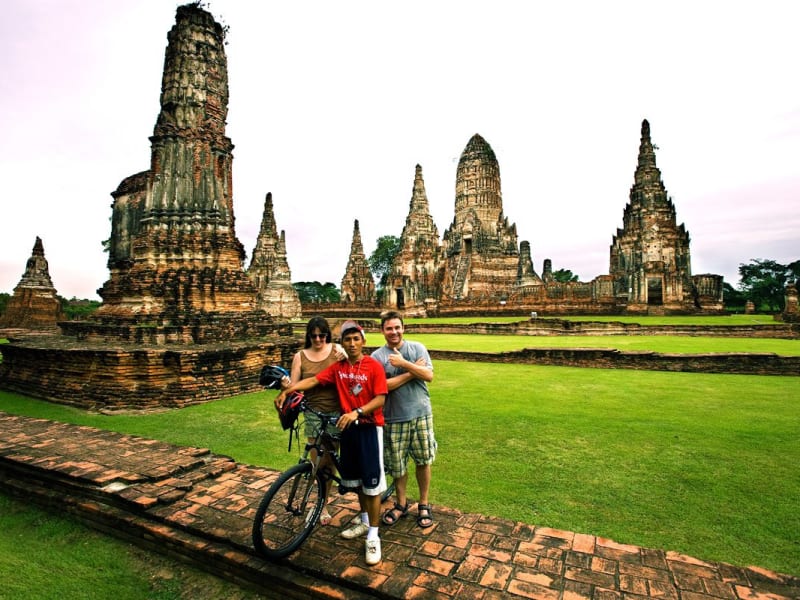Ayutthaya Historical Park stands as a monument to the ancient grandeur of Thailand’s second capital, capturing the imagination of visitors with its stunning ruins and rich history. Once a thriving center of commerce, culture, and power, the city of Ayutthaya is now a UNESCO World Heritage Site that invites you to step back in time.
Through this guide, we will explore Ayutthaya Historical Park in detail, from its historical significance to practical tips on visiting. This article also provides crucial information on the Ayutthaya Historical Park location and the services available at the Ayutthaya Historical Park office, helping you make the most of your journey.
I. The Rise and Fall of Ayutthaya: A Glimpse Into History
Ayutthaya Historical Park is located in Thailand’s central plains, about 85 kilometers north of Bangkok. Established in 1350 by King Ramathibodi I, Ayutthaya quickly grew into one of the most prosperous cities in Southeast Asia. Positioned strategically between China, India, and the Malay Archipelago, the city became a thriving trading hub, attracting merchants from around the world, including Europe and Japan.
For over 400 years, the Kingdom of Ayutthaya flourished, known for its opulent palaces, stunning temples, and impressive infrastructure. It was a beacon of wealth and power, its influence stretching far and wide.
However, in 1767, Ayutthaya met a tragic fate when it was invaded and sacked by the Burmese army. The once-majestic city was left in ruins, and the kingdom collapsed. Today, the remnants of this ancient civilization are preserved within Ayutthaya Historical Park Thailand, where you can explore the history and stories of the fallen empire.

Thailand, Ayutthaya
II. Discovering the Highlights of Ayutthaya Historical Park
The park encompasses an area of around 289 hectares and is home to numerous ancient temples, palaces, and monuments that stand as a testament to Ayutthaya’s former glory. Here are some must-see attractions when visiting Ayutthaya Historical Park:
Wat Phra Si Sanphet
Once the grandest temple in Ayutthaya, Wat Phra Si Sanphet served as the royal chapel, similar to Bangkok’s Wat Phra Kaew today. Built within the grounds of the former royal palace, this temple is famous for its three towering chedis that housed the ashes of Ayutthaya’s kings. Although heavily damaged during the Burmese invasion, the ruins of Wat Phra Si Sanphet remain a powerful symbol of the kingdom’s former prestige.

Wat Phra Si Sanphet – one of the most beautiful temples located within Ayutthaya Historical Park
Wat Mahathat
One of the most iconic images associated with Ayutthaya Historical Park Thailand is the Buddha head entwined in the roots of a banyan tree at Wat Mahathat. This temple, which served as the religious and political center of the city, dates back to the 14th century. While much of it was destroyed, the site’s significance endures, making it a key attraction for those seeking to understand the spiritual heart of Ayutthaya.
Wat Chaiwatthanaram
Positioned along the banks of the Chao Phraya River, Wat Chaiwatthanaram is one of the most visually striking temples in Ayutthaya. Built in 1630 by King Prasat Thong to honor his mother, the temple’s design was inspired by the architecture of Angkor Wat in Cambodia. With its central prang surrounded by smaller chedis, Wat Chaiwatthanaram is particularly enchanting at sunrise or sunset.

Wat Chaiwatthanaram – a masterpiece of historical architecture at Ayutthaya Historical Park
Wat Lokayasutharam
This temple is home to one of the largest reclining Buddha statues in Thailand, measuring an impressive 42 meters in length. The serene expression on the Buddha’s face has drawn worshippers and visitors alike for centuries. Despite being damaged during the fall of Ayutthaya, Wat Lokayasutharam remains a peaceful site where travelers can reflect and appreciate the spiritual heritage of the kingdom.
Wat Ratchaburana
Built in 1424 by King Borommarachathirat II, Wat Ratchaburana commemorates the tragic deaths of the king’s brothers, who perished in a duel for the throne. The temple’s main prang is remarkably well-preserved, allowing visitors to climb inside and explore ancient murals and relics hidden within the temple’s crypt.
III. Ayutthaya Historical Park Office: Visitor Information and Resources
For an enriching experience, it’s essential to visit the Ayutthaya Historical Park office before beginning your exploration. The office provides detailed maps, brochures, and information on guided tours that can deepen your understanding of the ruins. Additionally, tickets to individual sites and group tours can be purchased here, and the staff can assist with bike rentals, which are a popular and eco-friendly way to navigate the park’s vast grounds.
The Ayutthaya Historical Park office is conveniently located near the park’s main entrance, making it an ideal starting point. Opting for a guided tour from this office is highly recommended, as it provides historical context to the ruins, helping visitors fully appreciate the significance of each structure.

For an enriching experience, it’s essential to visit the Ayutthaya Historical Park office before beginning your exploration
IV. Ayutthaya Historical Park Location: How to Get There
The location of Ayutthaya Historical Park makes it easily accessible from Bangkok, making it a popular destination for day trips. Situated on an island surrounded by three rivers — the Chao Phraya, Lopburi, and Pa Sak — the park is well connected by both public and private transport options:
- By Train: One of the most scenic and affordable ways to reach Ayutthaya is by train. Departing from Bangkok’s Hua Lamphong station, the journey takes approximately 1.5 to 2 hours. From Ayutthaya station, you can easily hire a tuk-tuk or rent a bicycle to explore the park.
- By Bus or Minivan: Frequent buses and minivans depart from Bangkok’s Mo Chit bus station. The ride takes around 1.5 hours, and once you arrive, the historical park is just a short ride away.
- By Car: If you prefer to drive, Ayutthaya is about an hour and a half from Bangkok. There is ample parking near the park’s entrances.
The Ayutthaya Historical Park location is well-marked and easy to navigate once you arrive. Whether you choose a guided tour, bike ride, or leisurely stroll, you’ll find that the ruins are spread out enough to offer a peaceful, uncrowded experience even during peak season.

Exploring Ayutthaya Historical Park by bicycle is a beloved experience
V. Best Time to Visit Ayutthaya Historical Park
The best time to visit Ayutthaya Historical Park Thailand is during the cool season, from November to February, when temperatures are mild and more comfortable for outdoor activities. During this period, the weather is perfect for walking or biking around the park, and you can fully enjoy the historical sites without the discomfort of intense heat and humidity.
Another ideal time to visit is during the annual Ayutthaya World Heritage Fair, held in December. This event celebrates the city’s rich history with cultural performances, traditional food stalls, and exhibitions that offer a deeper understanding of Ayutthaya’s legacy.

From November to February is considered the best time to explore Ayutthaya Historical Park
VI. Tips for Exploring Ayutthaya Historical Park
- Dress Modestly: As with most temple sites in Thailand, respectful attire is required. Covering your shoulders and knees is expected when visiting sacred sites.
- Bring Water and Sunscreen: The park is large, and there is limited shade in some areas, so it’s important to stay hydrated and protect yourself from the sun.
- Rent a Bicycle: Biking is a popular way to explore the park. The terrain is flat, and cycling allows you to cover more ground and reach more remote parts of the park.
- Hire a Guide: The ruins can be enjoyed on your own, but having a knowledgeable guide can make your visit more meaningful. You’ll gain insight into the history, architecture, and legends of each site.

Ayutthaya Historical Park is a cultural journey
Ayutthaya Historical Park offers an unparalleled journey through Thailand’s ancient past. As you wander through the majestic ruins, it’s easy to imagine the once-thriving kingdom that shaped so much of the country’s history and culture. The remains of temples, palaces, and statues give a glimpse of a world long gone, but not forgotten.
Ayutthaya Historical Park Thailand is a must-visit destination that promises both education and inspiration. Contact Lux Travel DMC right away if you need advice or are planning a perfect trip to Thailand.
